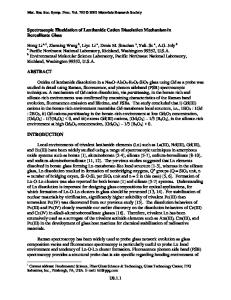Reaction mechanism of gold dissolution with bromine
- PDF / 1,089,423 Bytes
- 13 Pages / 603.28 x 783.28 pts Page_size
- 86 Downloads / 389 Views
I.
INTRODUCTION
C Y A N I D E has been the standard reagent for gold and silver dissolution ever since the cyanidation process was discovered. Its simplicity of application, use of basic solutions, and complexation chemistry have accounted for its long-term success. However, because the toxicity of cyanide is now raising some environmental concerns, alternative lixiviants for gold are being sought. Recently, there has been substantial research interest in reexamining the importance of halogen chemistry in gold metallurgy. This same chemistry was regarded as the most promising until the emergence of cyanidation. Among the halides, bromine has received the most attention, primarily because of its chemical properties.
The Application of Bromine for Gold Dissolution A literature review on the application of bromine for gold dissolution reveals two widely separated periods of activity, the first in the late 19th and early 20th centuries and the second in the last 10 years. Only a brief overview is given below. That bromine can dissolve gold from ores was first documented by Shaeffer m in an 1882 patent. His process was improved by Hinman, ~21 who realized the need for an excess amount of bromine and its regeneration during the dissolution of gold from ores. The bromination process was further improved by Cassel, I31 who first used an alkaline medium to recover bromine in the form of bromate salts and subsequently produce bromine in situ by acidification. Fink and Putnam L41patented the application of chlorine for either in situ production of bromine or its regeneration. BATRIC PESIC, Professor, is with the Department of Metallurgical Engineering, College of Mines, University of Idaho, Moscow, ID 83843. RODNEY H. SERGENT, Business Manager-Commercial Development, is with Great Lakes Chemical Corporation, West Lafayette, IN 47906. Manuscript submitted October 2, 1992. METALLURGICAL TRANSACTIONS B
Within the last l0 years, the Great Lakes Chemical Corporation t5,61 initially developed the N-halo hydantoins (GEOBROM* 3114 and G E O B R O M 5500) to serve as *GEOBROM is a trademark of Great Lakes Chemical Corporation, West Lafayette, IN.
the sources for bromine in leaching solutions. Subsequently, an inorganic product, GEOBROM 3400, which contains about 34 pct bromine as Br2, was developed as the source of bromine for gold dissolution. 17-~~ Among the other recent developments in the application of bromine for gold dissolution is the so-called "K-Process, "till owned by Kaljas Pty Ltd., which is based on the use of elemental bromine and bromide. In general, publications on the chemistry of the gold-bromine system have lacked fundamental information about that chemistry. For that reason, a basic study on the reactions between bromine and gold was performed, by use of a rotating disk technique.
II.
EXPERIMENTAL METHODS
Apparatus, Conditions, and Technique The apparatus for the rotating disk study consisted of a rotator, a speed controller, a reactor vessel (V = 0.5 L), and a temperature-controlled water bath. The rotati
Data Loading...










